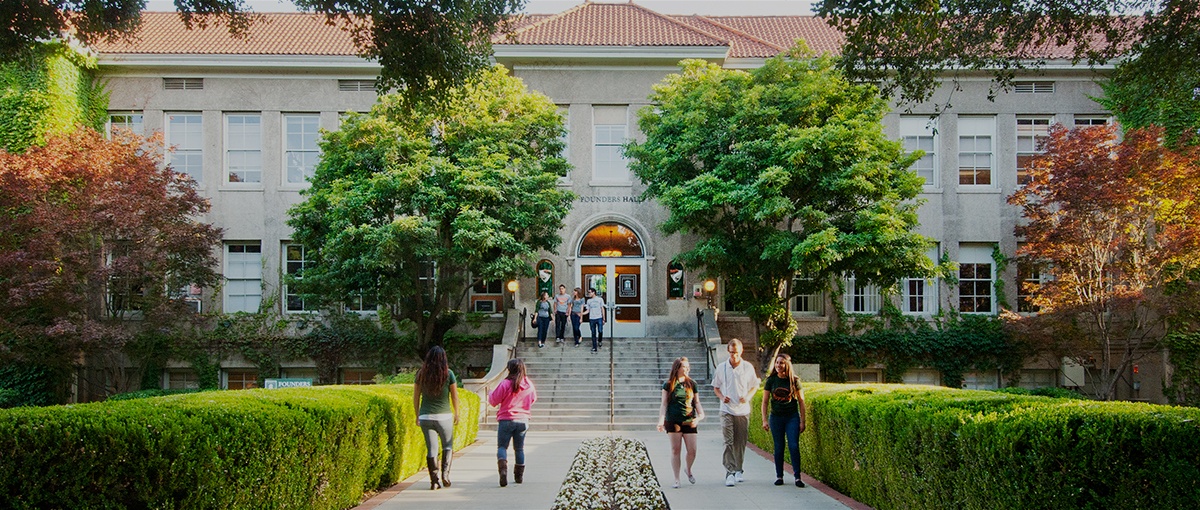As a university with more than 125 years of history, it’s no surprise we have some cherished traditions and lore. Here are a few things to know about the University of La Verne:
Lordsburg and La Verne
The university was originally founded as Lordsburg College in 1891 in the small agricultural community of Lordsburg. The college was housed in the Lordsburg Hotel, a large beautiful Victorian-era hotel built during a land boom that quickly ended; it’s said the hotel never saw any paying guests. Both the College and the town were renamed La Verne in 1917. Today, you’ll still see the name Lordsburg around campus — for example, the Lordsburg Debate Union, founded in 1912 — and in La Verne as a nod to the origins of the college and town.
The Leos
The official mascots of the University of La Verne are Leo and Lea the Leopard. You’ll “spot” odes to leopards across campus and find Leo gear in the Campus Store.
School Colors
La Verne boasts a bold orange and green palette as its official school colors. They serve as a connection to both the region’s history as vast citrus orchards and its subsequent growth along the railroad industry that populated the San Gabriel Valley in the early 20th century.
Homecoming
We love celebrating Homecoming each fall as alumni return to campus to cheer on the Leos in a home football game against one of our cross-town rivals. Student clubs and organizations represent at the Homecoming Street Fair and everyone enjoys the creativity of the Student Float Parade.
The Rock
For more than 60 years, students at the University of La Verne have practiced a cherished tradition: painting the rock located in front of Founders Hall. In the early days, the rock was just painted green with an orange LVC (when the University of La Verne was still called La Verne College); rival schools would even steal it. In the early 1960s, students replaced it with a large boulder from the nearby San Gabriel Mountains and buried much of it so it could no longer be taken.
Since then, the rock has become the place for students to announce celebrations and promote organizations. Early on, competing organizations would prank one another, repainting the rock overnight to replace other clubs’ messages. It’s a tradition that almost all students involved in clubs and organizations experience during their four years — a tradition that builds memories and is unique to the University of La Verne.
Sneaky Park
Sneaky Park, adjacent to Wilson Library, is the site of many outdoor student events on campus, from Earth Day festivities and the annual International Educational Festival to cultural club celebrations like the Hawaiian Club’s annual Luau, the Latino Student Forum’s Cinco de Mayo celebration, and the Cherry Blossom Festival sponsored by the Japan Daisuki club. You’ll also find a small amphitheater where musicians perform, and a leopard statue celebrating the Leos. One of our La Verne traditions is for graduates, while walking back from baccalaureate services, to touch the paw of the leopard statue and the book of knowledge as they pass, reminders of their alma mater and lifelong learning as they enter the world.
Super Tents
The University of La Verne Sports Science and Athletic Pavilion and the Dailey Theatre are located in quirky buildings that catch your eye the moment you step on campus: “The Super Tents,” built in the early 1970s, were the world’s first permanent–tensioned membrane structure, created with a then-new fabric of woven fiberglass coated with Teflon. At the time, the growing college needed a variety of facilities. Dr. Leland Newcomer, university president from 1968 to 1975, described the Tents as “six in one” because it would have taken six buildings to do what the tent complex could.
When the tents opened, they served a variety of purposes: facilities for the Athletic, Art, and Communication Departments, including the school newspaper and TV and radio stations; a student snack bar and game area; an innovative NCAA-regulation gym for basketball and volleyball; and a unique Quonset hut for the Health Center. A separate tent structure housed the developing Theatre Arts program. In recent years, Communications and Art have moved out and the tents were rechristened the Sports Science and Athletic Pavilion. More than 40 years later, this innovative structure still serves the needs of students at the University of La Verne while fascinating newcomers and visitors with its futuristic look.
Beyond (the City of) La Verne
Our educational opportunities extend far beyond campus. We have online students who complete their bachelor and graduate degrees remotely, and we have 10 other campuses across Southern California, including two located on military installations. We also have nontraditional undergraduate students who require flexible weekend and evening classes in our Campus Accelerated Program for Adults (CAPA). Visit our locations page to learn about all the places Leos learn.
